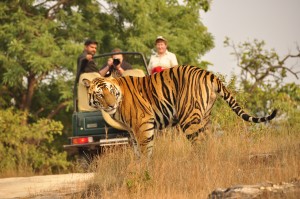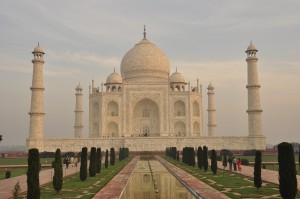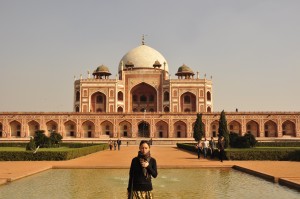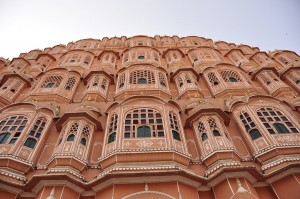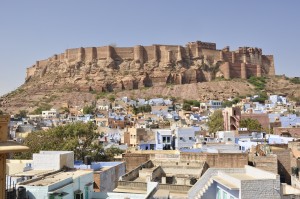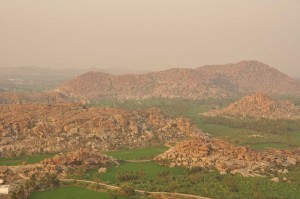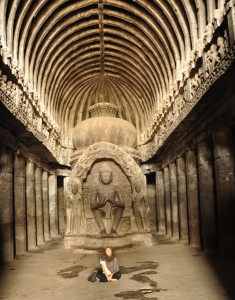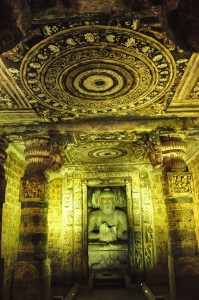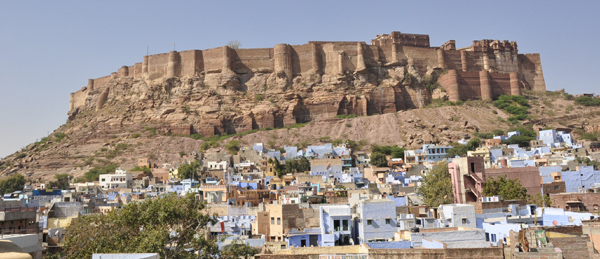It appears that detailed, timely blog postings on our adventures has proven to be a most elusive skill so far in our travels. So… in order to keep things moving and regular (and also break up the tedium of introspective contemplations), I thought bundling a lazy, slightly irreverent, but mostly expedient take on the “Incredible India” sights into a single post might be worth a go.
This really is in no particular order or actually a Top 10! But it should give you the quick skinny (plus some snaps) on the touristy, but nevertheless stunning stuff that we have checked out along out merry way around India. I will keep adding to this and updating it as we go, so be sure to check back!
1) The Bodhi Tree – Bodhgaya
The spot where Buddha reached enlightenment is marked by a beautiful park, monolith, many monasteries and a huge tree that is a direct cutting from the original Bodhi tree. The park vibrates with a magical, spiritual energy and peace, as thousands of monks from all countries (in all colours) meditate, chant, relentlessly protraste themselves on special boards or circumambulate the site and its prayer wheels – all simply amazing to behold. Of course there is precious little space under the tree for a conservatively dressed Australian, even with the peaceful application of the elbows; all the good spots are well staked out by the many Tibetan, Bhutanese, Thai or Nepali’s who have trained for decades to get up at 4am; all keen to have another stab at seeking enlightenment and some divine inspiration. While we were there an international Thervada Chanting Conference was taking place (Lots of Thai, Lao, Vietnamese and Korean monks) plus thousands of Tibetans were in town (including the 17th Karmapa) so the place was jumping. Outside the park though, Bodhgaya is classic India – poor, dusty, loud, confusing with hundreds of beggars lined up to prey on the Buddhist’s karmic conscience.
2) The Erotic Temples – Khajuraho
Built around the 11th -14th century, the stone carvings on these temples are simply amazing in their intricacy though not nearly as erotic as every tourist brochure would have you believe – but then India is very conservative these days. The said scenes, when you can find them amongst the thousands of detailed sculptures, represent various states of undress, a few interesting positions and some rather more bestial explorations with horses and elephants. Set in 3 locations around the small town, the temples make a pleasant days viewing and feature a ‘sound and light’ historical show at night which is actually worth checking out. Right outside the park though (and everywhere else actually) touts outnumber the tourists 10 to 1 and do really test the patience. Endless in-your-face demands to buy sex keyrings, books on karma sutra or enter discussion on the servicing of multiple wives and girlfriends abound in English, Japanese and a dozen other attempted languages. The Indians seem to think that any tourist checking out this sight has to be as debauched, kinky and sex obsessed as the average Indian male’s secret imagination and fantasies – which is a pretty tall ask believe me – be warned.
3) Tiger Safari – Bandhavgarh National Park
Bit out of the way this one, but definitely worth it. With the highest density of Tigers in India, this is the best place to see one in the wild of anywhere, so we splurged a bit to have a couple of cracks. Initially we tried to do the safari on an elephant back’s – but the bull (male) phant was horny, the female was on heat and the other elephant was knocked up – so we were humbly reduced to a jeep. Our first safari at sunrise accompanied by a guide, roamed the misty dirt tracks & waterholes in the jungle looking for tiger prints (there were many) and listening for monkey & bird alarm calls (constantly) that tell you a Tiger is near. 4 hours later we gave up, though we did see stacks of deer, eagles, vultures, monkeys, wild boar and other stuff. No-one else saw a tiger that morning either which was strangely satisfying. Doubling down, we went back in the afternoon for a sunset session and got immediately lucky. Within 15 minutes, the jungle went wild with monkey calls and we tore up the dirt track to discover a huge, 2 year old tiger lying happily on the track. Completely ignoring the mad, camera totting jeep creatures around him – he then proceeded to walk along the road for 20 minutes with us snapping wildly behind, stopping for an occasional roar, stretch or snooze. In total we got an hour of wild tiger face (& photo) time which is pretty much unheard of!
4) Agra– Taj Mahal, Baby Taj, Agra Fort, Fatephur Sikri
India’s number 1 destination and rightly so – Agra is jam packed with incredibly history and architectural wonders and worthy of at least a couple of days exploration. It is also full of pushy Indian tourists, egotistical guards, dodgy guesthouses, annoying rickshaw drivers, postcard sellers and squirrels! The Taj is amazing – everyone should see it at some point and a million better minds than mine have described its splendours eloquently; what they don’t tell you though is that its very expensive; ridiculously crowded (trying to get a clear shot is impossible next to a thousand other Indians with no sense of personal space all trying to do the same); oh and the security guards are arseholes. They had the audacity to confiscate Megumi’s finger puppet P-chan, banning him from entry. Apparently soft toys constitute both a significant religious and terrorist threat (the line of crying babies was more than 50m long). After our own angry confrontation and a lot of Indian hand and head waving – we left in disgust. To balance this experience though, we did happily discover the somewhat secret Baby Taj (Itimad-ud-Daulah) – a smaller, earlier constructed, similar completely marble tomb – that while not as stupendous it is just as fascinating architecturally, much cheaper, was all to ourselves and happily not intimidated by the presence of finger puppets. The Agra Fort is also a stunning complex and steeped in interesting architecture, politics and history, though most recently invaded by squirrels it is well worth the visit, if only just to comprehend the palatial harems of the great Mughals. A short bus-ride out of Agra is also the fort town of Fatephur Sikri- an equally magnificent fort, mosque and ranging red marble conquest, that fully warrants a days adventuring.
5) Delhi – Red Fort, Humayun’s Tomb & Old Delhi Markets
Delhi was quite the surprise – green, full of parks and possibly the most unpolluted city we visited in India. It teems with ancient ruins and innumerable testaments to the Moghul era and other age’s past littered across the Delhi landscape, seemingly so integrated into the Delhi urbanity that they are easily overlooked. We spent plenty of time exploring and still really only scratched the surface. The red fort is the major attraction and though impressive from the outside, inside it is a very poor cousin to the forts of Agra, Fatephur Sikri and Rajasthan, hardly worth the entrance fee. Much more compelling was Humayun’s Tomb, an early predecessor to the Taj Mahal and set amongst an amazing park like complex of different tombs, sculptures and gardens very well preserved. We didn’t make the largest mosque in India,the Jama Masdjid, but did wander the nearby ancient market complex’s and labrynths’ of old Delhi. An endlessly fascinating maze of thematic markets – spices, fruits, fabrics, wedding jewellery, sweets – you name it, there is a mind numbingly complex, bustling, dedicated market to suit all tastes here. An endless insight into India’s true inner workings and a real orgy for the senses – though you would require several days to come close to getting your head around what’s what and what’s really going on.
6) Jaipur – The Amber Fort, Hawa Mahal & the pink city
Jaipur was a bit dissapointing to be honest, though perhaps its a view tarnished a tad by a sordid dose of Delhi Belly. The city is indeed pink and the fort and key monuments are contained within large square, well organized streets each with specialized markets and wares largely unchanged in centuries. The Hawa Mahal was definitely a highlight – the palace where the Maharaja kept his wives and harem, all cleverly designed so that they could see out but the public could not see in. The palace itself is quite amazing with all the wealthy trims of the Rajasthani elite and the surrounding hills and lakes are all scenically peppered with other forts, summer palaces. Most interesting perhaps was the Maharaja’s astrological centre, full of large complex astrological sun dials and other such toys, the envy of all star gazing obsessives everywhere. The Rajasthani food is also amazing and markets abound with Rajasthans famous jewelry and threads, but all this is offset by a big city vibe and the constant harassment from touts, shopkeepers and most of the locals you meet. Constantly on the defensive, its not a friendly or comfortable place and a day is more than enough for the sites, 2 or 3 due to illness is definite overkill and not worth the resulting sacrifices to our Rajasthan tour!
7) Jodhpur – Mehrangarh Fort & the blue city
The city really is blue and dominated by the amazing fort that sits on the hill in the centre of town. The fort is a perfectly preserved vision of the Maharaja’s of Rajasthan lifestyle and impregnable military might and an easy way to fill in a day. We stayed in a beautiful, 500 year old haveli under the fort walls and were completely enchanted by the town itself. The blue buildings represent bramin (Hindu caste elite) houses and the town is a labyrinth of tiny, winding back alleys and shops that are fascinating to wander. The place does not feel like it has changed that much in the last 3 or 400 years. The people costume up nicely with plenty of fat, Rajasthani mustaches to savour and are generally quite friendly, approachable and proud; though the dogs do seem to be particularly viscous – carry a stick! Its also a great place to sample the many delights of the Rajasthani diet.
8) Hampi – Rocks, ruins and relaxation
Hampi takes you by surprise. Nestled inland to the South, it is easily accessible from Goa and acts as a perfect relaxation and recovery haven for travellers. Set on 2 sides of a river, it is a holy city, one side an active mecca for Indians, while the other side, accessible by a single small rowing boat, is a relaxing collection of cheap backpacker friendly, huts. The surrounding area is literally littered with the ancient ruins of temples and magnificent sculptured palaces from ages past, all set against stunning stone covered hills and rice paddies that form the most amazing backdrop that we encountered in India. You can happily spend weeks here in a traveller bubble, with little agenda other than relaxation and meeting other like minded folk. There is plenty of yoga, a large lake and river to swim in for the hot days, casual movie nights and endless adventures further afield to explore the many ruins and temples on motorbike or check out some of the best rock climbing in India. The highlight for mine, was the Hanuman (Monkey god) temple at the top of a mountain. The temple is occupied by a bunch of sadhu’s seemingly glued to their chillum’s, but its all about the stunning views of the landscapes in all directions. Highly recommend it if you get the chance, a hard place to leave!
9) Ellora – Buddhist, Hindi & Jain cave temples
Ellora and the somewhat adjacent Ajanta were probably the highlight of all the stunning ancient sights that we visited in India. Ellora is located about 30 or 40 minutes out of Aurangubad and incorporates a vast network of caves literally carved out of the cliff-faces in the 1st to the 8th century. There are more than 40 cave temples in total and each represents a kind of time capsule of India’s various religions of the time divided into 3 major sections – sets of buddhist, hindu and Jain temples. The detail of these temples is completely amazing, some of the temples are massive and represent hundreds of years of chipping away at rock faces to create the space, let alone craft the thousands of intricate statues contained within each. The buddhist temples were a lot more minimal, focused on monasteries, prayer & education halls and music / meditation chambers. While the hindu temples were of a grand scale with thousands of intricate sculptures and temples designs dedicated to the major deities. Unfortunately our temple tour was cut short at the magnificent Kailash temple (the largest and most stunning) when someone’s flash set of a swarm of bee’s. I was stung at least 20 times on the head and arms as I was fleeing the temple and enveloped in a swarm of bee’s that chased me some 200 metres outside the complex. They only desisted when I buried myself in a pile of smoking leaves, the guards pointed me at. As helpful as they were the guards seemed quite relaxed and content to get the whole thing on video; it seems this is nothing unusual at this time of year – be warned. Even with a swollen face and savagely stung pride though, the bewildering wonder at human achievement was only marginally subdued and we didn’t even get to the Jain temples, with supposedly the best sculptural detail. Another time perhaps!
10) Ajanta – Buddhist cave temples and frescoes
Located a couple of hours out of Aurangubad, Ajanta was re-discovered by an Englishmen a few centuries ago while hunting a tiger. The tiger they were tracking disappeared into a cave somewhere out of sight and on further investigation, plus some backing from the local Maharaja, they discovered this set of 26 odd caves completely buried and overtaken by the bush. Each of the caves, like Ellora, were hand carved into the mountainside between the 1st and 5th century and while similarly full of scultptures, due to being largely hidden from the world for 1500 years or so, Ajanta contains walls covered with some of the most amazing frescoes and paintings from that time still largely intact. All of the caves here are Buddhist monasteries and temples, some with adjoining meditation rooms, while others are unfinished and therefore still show how the temples were made (by hammer and chisel). An archeologists absolute wet dream, the paintings and buddhist sculptures here leave you speechless and very much in awe of the skill and dedication of the ancient Indian devotee’s and how alive buddhism must have been. An absolute must see for mine.
More pics coming when I actually score some free bandwidth and a day off!
![India – The Sights It appears that detailed, timely blog postings on our adventures has proven to be a most elusive skill so far in our travels. So… in […]](http://meltingplots.com/wp-content/uploads/2009/12/DSC79471.jpg)


